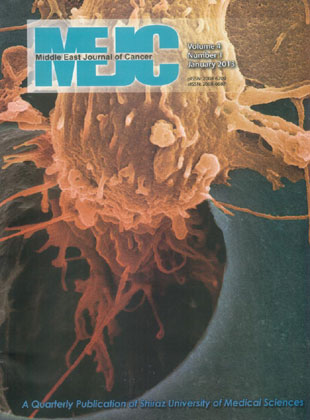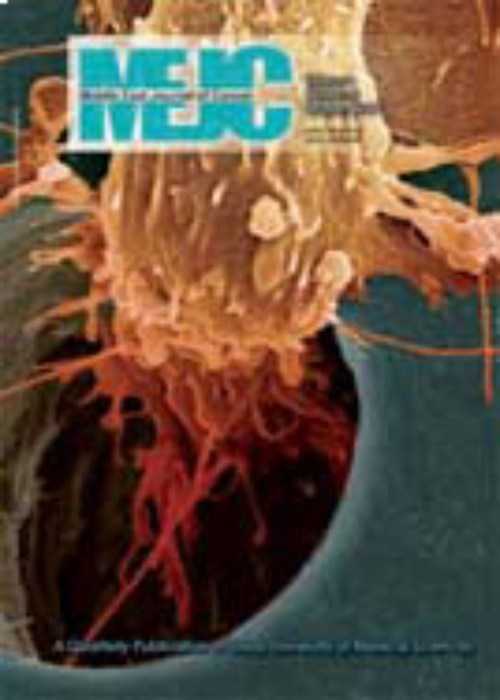فهرست مطالب

Middle East Journal of Cancer
Volume:4 Issue: 1, Jan 2013
- تاریخ انتشار: 1392/01/27
- تعداد عناوین: 7
-
-
Page 1BackgroundAccording to numerous studies, FMS-like tyrosine kinase 3, internal tandem duplication, and the D835 mutation are associated with a poor prognostic clinical outcome in acute myeloid leukemia patients. Detection of the FMS-like tyrosine kinase 3 mutation in patients who present with normal karyotype acute myeloid leukemia helps in both the understanding of the disease and the treatment of patients. This study evaluates the incidence of FMS-like tyrosine kinase 3-internal tandem duplication and FMS-like tyrosine kinase 3-D835 mutation in newly diagnosed patients with normal karyotype acute myeloid leukemia.MethodsThis study looked at 33 new cases who presented with normal karyotype acute myeloid leukemia at diagnosis. We collected peripheral blood samples from patients at diagnosis. FMS-like tyrosine kinase 3-internal tandem duplication mutation was detected using polymerase chain reaction and FMS-like tyrosine kinase 3-D835 mutation by restriction fragment length polymorphism after polymerase chain reaction.ResultsFMS-like tyrosine kinase 3-internal tandem duplication mutation was found in 18% (6/33) of all patients and in 30% (6/20) of patients over 30 years of age. FMSlike tyrosine kinase 3-internal tandem duplication mutation was most common with M2 (50%), M5 (33.3%), and M0 (16.7%). FMS-like tyrosine kinase 3-D835 mutation was detected in one patient (3%) that had M2. No significant association was found between FMS-like tyrosine kinase 3 mutation and age, sex, white blood cell count, platelets, or blasts percentage.ConclusionMost of FMS-like tyrosine kinase 3 mutations were found in patients older than 30 years. The frequency observed in this work is comparable with that observed in the literature. No pediatric case of FMS-like tyrosine kinase 3 mutation was found in this study. A large scale study is needed to confirm our findings and to further appreciate the prognostic value of FMS-like tyrosine kinase 3 mutation among Moroccan patients.Keywords: FMS, like tyrosine kinase 3, FLT3, ITD, FLT3, D835, mutations, NK, AML
-
Page 7BackgroundMDM2, E-cadherin, survivin and Her2 genes are involved in the regulation of normal cell growth. However, any crucial change in their expression levels can convert a normal cell into a cancer cell. Numerous studies have identified alterations of these gene expression levels in various cancers, particularly in breast cancer. Thus, they may be used as diagnostic biomarkers. In this experiment, we aim to evaluate these gene transcripts in patients’ peripheral blood and compare the results with healthy individuals.MethodsRNA was extracted from peripheral blood cells of 52 breast cancer patients and 52 healthy volunteers. Then, cDNA was synthesized and assessed for MDM2, E-cadherin, and survivin and Her2 gene transcriptions in peripheral blood samples by quantitative real-time polymerase chain reaction.ResultsThere were no considerable differences in the expression of MDM2, Ecadherin, survivin and Her2 in cancer patients compared to healthy individuals. However, there were significantly correlation between E-cadherin, survivin and Her2 expression and some of the clinicopathological characteristics of patients studied. Also, survivin transcripts expression was positively correlated with Her2, E-cadherin, and MDM2 gene expressions.ConclusionThese results indicated no variations in MDM2, E-cadherin, Her2 and survivin gene expressions in patients compared to controls. We might not consider the examined biomarkers as valuable prognosis factors in primary breast cancer. However, additional research should be undertaken to assess these four genes in a larger sample size.Keywords: Breast cancer, MDM2, E, cadherin, survivin, Her2
-
Page 15BackgroundOvarian cancer is the leading cause of death among gynecological cancers. Changes in the methylation of BRCA1 and BRCA2 may be an effective mechanism for breast and ovarian cancer. This study evaluates the protein expression and methylation status of BRCA2 in Iranian patients.MethodsWe assessed 60 Mullerian-type ovarian cancers by methylation-specific PCR assays and immunohistochemistry.ResultsAccording to methylation status analysis, there were 7 of 60 (11.66%) methylated cases that had low protein expression.ConclusionWe concluded that changes in the methylation status of BRCA2 cannot be used as an appropriate biomarker to ascertain the development of ovarian cancer.Keywords: Ovarian cancer, Tumor suppressor, Methylation
-
Page 21BackgroundThymoma and thymic carcinoma are relatively rare tumours of the anterior mediastinum. Optimum treatment options for these tumours remain unresolved, although at present, a multimodality approach involving aggressive surgical resection, platinum-based combination chemotherapeutic interventions and radiotherapy represents the preferred therapeutic approach.1-3 This study evaluates the treatment outcome of patients with thymic tumours at our centre.MethodsWe retrospectively reviewed clinical case notes, electronic patient records, imaging and radiation treatment records of patients treated at Clatterbridge Cancer Centre.ResultsA total of 21 patients diagnosed with thymic tumours were treated at Clatterbridge Cancer Centre between June 1990 until June 2011. There were 12 (57%) out of 21 patients who received multimodality therapy (chemotherapy and/or radiation therapy and/or surgery), 7 (34%) received single modality treatment and 2 (9%) did not receive any treatment. Relapse occurred in 10 (47%) patients with a median time from primary diagnosis to relapse of 28 months (10 to 104 months). Among those who relapsed, 6 died with a median survival of 58 months (53 to 64 months). Out of 12 patients in the multimodality treatment group, 9 (75%) remain alive with a median follow up of 45 months. In 7 patients who received single mode therapy, 5 (71%) died with a median survival of 45 months. 2 patients who did not receive any treatment died. Overall median survival in 10 of 21 patients who died was 42 months (2 to 192 months).ConclusionMultimodality treatment for thymic tumours represents the preferred therapeutic approach and should be considered in suitable patients. Further randomized trials are necessary to define the optimum treatment options.Keywords: Thymoma, Thymic carcinoma, chemotherapy, Radiotherapy
-
Page 27BackgroundThere has been a rapid increase in cancer among Sudanese citizens from 1999 until this year. At least 80% of all patients who undergo chemotherapy will develop anemia as a complication. This inpatient analytical comparative study aims to examine the possible association between hemotoxicity and various chemotherapy regimens in Sudanese children diagnosed with retinoblastoma.MethodsThis study enrolled 30 patients diagnosed with childhood retinoblastoma who were admitted from June 2006 to September 2008 to the Radiation and Isotope Center Khartoum. We collected 90 blood samples to examine for a possible association between anemia and the chemotherapeutic regimen. All patients (n=30) were included in each arm of the chemotherapy regimen.ResultsPrior to the onset of chemotherapy, 50% of patients had normal hemoglobin levels, 43.3% had mild anemia, and 6.7% had moderate anemia. Post-cycle I treatment, there were only 6.7% who had normal hemoglobin levels. Mild anemia was observed in 60%, followed by 30% for moderate anemia and 3.3% of patients had severe anemia. Post-cycle II there were no patients with normal hemoglobin levels, however 26.7% had mild anemia and the majority of patients (approximately 73.3%) had moderate anemia.ConclusionA correlation existed between hemoglobin values after completion of therapy to the overall treatment. We observed a decline of 1 to 2 g/dl in hemoglobin levels.Keywords: Cancer, Solid tumor, Retinoblastoma, Chemotherapy, Anemia
-
Acute Acquired Demyelinating Polyneuropathy:An Initial Presentation of Diffuse Large B Cell LymphomaPage 35Neurological signs and symptoms are commonly associated with both Hodgkin’s and non-Hodgkin’s lymphoma and are mostly attributed to either direct lymphomatous involvement of the nervous system, either as a result of extension to the spinal cord or nerves, or due to infiltration by lymphoma cells and drug toxicity. Guillain-Barre syndrome and its variants have been reported very infrequently in the literature. We present the case of a 70-year-old male admitted to the hospital for evaluation of uncontrolled hypertension. Incidentally, he was noted to have a low platelet count and a leukoerythroblastic picture in the peripheral blood. Two days into admission, he developed bilateral symmetrical ascending paresis consistent with acute acquired demyelinating polyneuropathy, a common variant of Guillain-Barre syndrome. At about the same time he developed worsening cytopenia and was diagnosed with diffuse large B cell lymphoma according to a bone marrow biopsy. The patient was treated with intravenous immunoglobulin for Guillain-Barre syndrome with significant improvement in muscle strength and subsequently treated with chemotherapy for his lymphoma.Keywords: Guillain_Barre syndrome_Diffuse large B cell lymphoma_Initial presentation_Intravenous immunoglobulin
-
Page 39Superior vena cava syndrome is a common presentation of bronchogenic carcinoma. The mechanism of obstruction is by compression of superior vena cava by the bronchogenic tumor itself or enlarged mediastinal lymph nodes. However obstruction due to intravascular thrombosis is extremely uncommon. Here, we report a rare case of a 65-year-old male smoker who presented with superior vena cava syndrome and bilateral pleural and pericardial effusion with thrombotic occlusion of the superior vena cava in adenocarcinoma of the lung. He was given chemotherapy with carboplatin and gemcitabine with anticoagulant therapy.Keywords: Adenocarcinoma, Lung, Superior vena cava, Thrombosis


